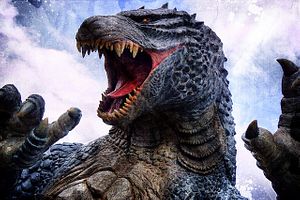If the trailer released in April is anything to go by, Godzilla Resurgence (Shin Gojira), could set a new bar for the series.
Set to a dramatic musical score and devoid of dialog, the minute and a half of footage teases viewers with scenes of epic destruction, as Godzilla looms above, swaying what appears to be the largest tail in the series’ history. Fleets of tanks, helicopters and battleships unleash a vicious onslaught of firepower against the gigantic, irradiated lizard – to no avail – as panicked military and government officials frantically formulate a game plan and terrified citizens flee for cover.
As the 29th installment in the monster’s sprawling filmography is being met with widespread anticipation, it begs the question: What gives Godzilla so much staying power?
“Godzilla resonates because it’s a great character, visually, acting-wise, all the ways that characters become great. It is a great anthropomorphic representation of forces beyond human control,” Matt Alt, author of numerous books on Japanese culture, including Yokai Attack!: The Japanese Monster Survival Guide, told The Diplomat.
Yet, as great as Godzilla’s appeal may be, it only goes so far. The film’s co-directors Hideaki Anno (Evangelion) and Shinji Higuchi (Attack on Titan) are keenly aware of the challenges at hand. “Godzilla went through these stages, resetting itself, developing and then succumbing to exhaustion, until it just got so big it had to stop,” Higuchi said.
Higuchi’s solution: Get back to basics. This essentially means casting Godzilla as it was in the original films – a monster hellbent on destroying civilization. In the 1950s this meant drawing on recent memories of Tokyo being razed by Allied bombings. Today, the imagery beamed out to screens across Japan following the natural disasters that have beset Japan in recent years, from Fukushima to Kumamoto, lend gravitas to the scenes of destruction left in Godzilla’s wake, as Alt mused in a recent article for The New Yorker.
“One of the things that’s hard to grasp for foreign audiences is that while the monster is obviously fictional, Japanese don’t see the scenes of destruction as simply just a dramatic backdrop. It’s something that could happen here,” Alt said. “I think that Godzilla Resurgence is going to heavily play up that natural disaster aspect, echoing the fears many Japanese have about the potential for another large-scale earthquake.”
In response to the trailer, Roland Kelts, author of the hit guide to otaku culture, Japanamerica, added: “Shots of the mobilizing blue-suited civil servants and piles of broken planks and debris quite nakedly echo scenes of the aftermath of the great Tohoku earthquake, tsunami and nuclear disaster.”
In the quest to create such harrowing footage in a believable way, Higuchi has vowed to employ a “hybrid” approach to special effects, involving a mix of cutting-edge computer graphics, an oversized Godzilla doll and actors moving through miniatures. The barrage of artillery featured in the trailer is courtesy of the Japanese military, which agreed to collaborate with the film crew.
Despite growing media attention on the remilitarization of Japan, Alt downplayed the possibility that the Japan Self-Defense Forces’ (JSDF) role in the film could be part of a right-wing agenda. “I think the deployment of the military in this film is rooted less in nationalism and more in the newfound respect for the JSDF that grew out of their rescue efforts during the 2011 tsunami and other disasters,” Alt said. He added: “The directors, and Anno in particular, have a real fetish for military hardware.”
This mélange of production elements leaves no expenses spared, and is a far cry from the methods used to create the original Godzilla films. Kelts is a self-proclaimed fan of the old-school tokusatsu techniques used by Toho Studios in the early days. He fondly recalls a far simpler, inherently comical model of the monster, tramping about a city made of cardboard.
“For me, the ultimate Godzilla of my dreams is the tokusatsu rubber-suited version that aired on late-night TV,” Kelts said. “The sheer physicality of both the creature and the model cities and landscapes was and remains irresistible. And unlike roaring or growling American giant monsters, Godzilla screeched like a strangled bird, which I found far more intimate and haunting.”
He continued: “The tokusatsu Godzilla made me think of a drunken sailor gone to seed, with its pocked, squashed and squinty-eyed face and sagging paunch, swinging blindly at the air, then stomping on stuff just for the hell of it.”
The image of a sailor hints at a deeper point, Kelts noted: “Several Japanese critics have pointed out that the original 1954 Godzilla was meant to embody the enraged spirits of Japan’s dead soldiers, who had been dismissed as losers and forgotten as the country embraced its former American enemy and the spoils of capitalism and Westernization. In the form of Godzilla, those spirits rise from their graves at the bottom of the sea, irradiated and vengeful, and proceed to crush the apartment buildings and office towers of a modernizing Tokyo.”
Today Japan finds itself at a very different crossroads. Embroiled in a number of territorial disputes and a decades long economic malaise, the country is now more focused on maintaining its status as a leader in Asia than wrestling with its nationalistic past.
Given these new realities, Alt said, “I don’t expect the new film to return to the tone of the 1954 film because the regional political calculus has so dramatically shifted.”
Kelts also downplayed the idea that the new film is likely to take on an overtly political tone, saying: “It’s hard for me to speculate without seeing it. [But] if Godzilla starts stomping on foreign tourists in Ginza, or takes a swipe at the tower in Pudong, then we’ll know.”
































